AMD's Phenom II X4 965 Black Edition
by Anand Lal Shimpi on August 13, 2009 12:00 AM EST- Posted in
- CPUs
And so it ends at 4GHz, again.
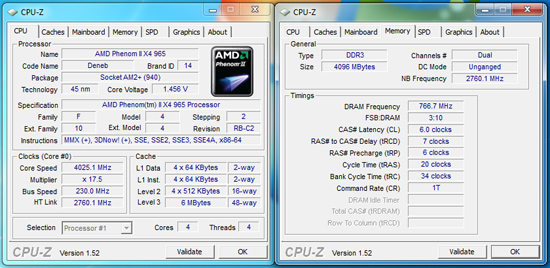
A 625MHz overclock is nothing to sneeze at, but it certainly does not come near those 6GHz~7GHz clock speeds we see on a regular basis with the Phenom II series. Granted, reaching those high clock speeds requires LN2 cooling but there is another important reason. We have discussed it several times and still do not have an acceptable answer from AMD about the inability of the Phenom II to clock much past 4GHz with a 64-bit operating system. Even with LN2 cooling we have not successfully benched past 4.4GHz with a 64-bit OS.
Once again, we tried XP 64-bit, Vista 64-bit, and Windows 7 64-bit and the results are always the same. As we near 4GHz, the voltage requirements increase dramatically and the clocking ability of the processor decreases in much the same manner. This does not occur in a 32-bit operating system, which happens to be the recommendation for any sort of benchmarking activities with the Phenom II.
That said, running this particular processor in the 3.8GHz~4GHz range offers performance that should satisfy just about any desktop user. Moreover, it is easy to do, in fact, much easier than our collection of 955BE samples scattered about the labs.
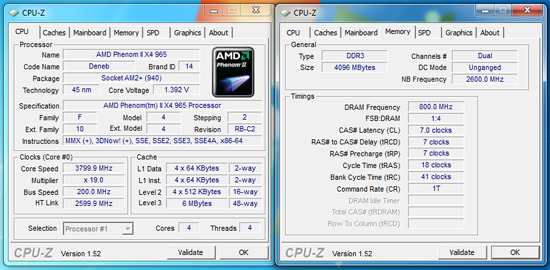
The stock Core VDDC (VCore) is 1.4V as delivered from AMD. At this stock voltage and a slight bump in NB Core voltage to 1.250V, we hit 3.8GHz with a 2.6GHz Northbridge speed on our MSI 790FX-GD70 motherboard. The AMD specific 4GB DDR3-1600 kit from OCZ was set at 1.65V with 7-7-7-18 1T timings. We used the retail air cooler and load temperatures stayed around 58C~62C with Windows 7 Ultimate x64 as the operating system of choice.
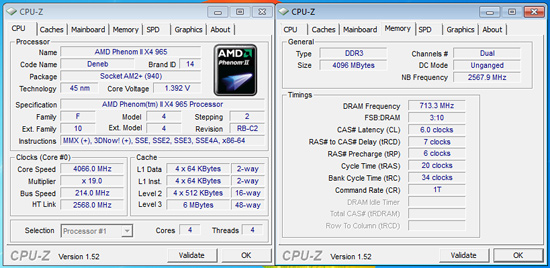
At the same voltages but utilizing Windows 7 Ultimate x86 we end at a final core speed of 4.066GHz (19x214). Northbridge speed is set to 2.567GHz and memory at DDR3-1426 with 6-7-6-20 timings. This is a similar pattern when testing the Phenom II cpus on air-cooling; we typically can clock the processor about 200MHz higher at similar voltages and settings when using a 32-bit OS in place of a 64-bit OS. Our particular sample made it to 4.2GHz on 1.50V with a NB speed of 2.4GHz using our Vigor Monsoon III LT air cooler. We almost hit 4.3GHz at 1.52V with a 2.7GHz NB speed on water cooling before temperatures spiraled out of control.
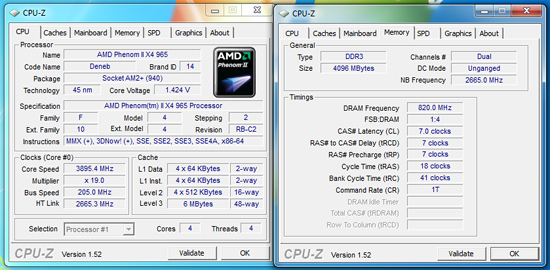
We swapped out our retail air cooler for the Corsair Hydro H50 to hit our top two overclocks. We reached 3.89GHz on 1.45V with the NB speed of 2.66GHz and memory running at DDR3-1640 on 7-7-7-18 timings. When running higher NB speeds, it is a requirement to keep the core as cool as possible to guarantee stability under load conditions. This was our preferred setting as temperatures stayed below 54C under load and the system was very responsive in a variety of applications, especially gaming.
Our best core clock reached 4.025GHz on 1.475V (shown at the top of the page) with a 2.76GHz NB speed and memory operating at DDR3-1532 on 6-7-6-20 timings. Temperatures crept back up to the 58C range under full load conditions.
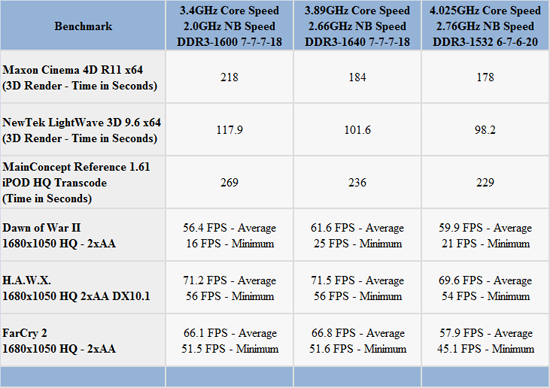
The 4.025GHz setting offered the best results in several video/audio transcoding benchmarks due to pure processor speed, it was actually slower in gaming than the 3.89GHz setting thanks to improved memory bandwidth and internal latencies.
















54 Comments
View All Comments
brybir - Thursday, August 13, 2009 - link
I did notice on newegg that AMD is releasing some of its Phenom II's with lower TDP.They have a Phenom II 945 that was rated at 125WTDP now with the same processor just rated at 95W TDP.
I figure they will goose the clock speed a bit more if they can and continue to work on getting their power consumption lowered on the rest of their line so by the time their new processors come out the Phenom II's can pull up low power budget duty.
Taft12 - Thursday, August 13, 2009 - link
I was going to mention this new part from AMD as well (945 95W edition). Anand you would do well to draw attention to it as well where you talk about AMD's current product lineup. This is a more interesting and notable introduction to me than this 140W behemoth.I was surprised to see the 965 only consumes 3W more at load than the 955BE however. Yes it draws the highest power on the chart, but only just barely.
werfu - Thursday, August 13, 2009 - link
What AMD needs is a way to improve performance per clock, that's it, either K11 or something new. There's no way they'll be able to scale much past the 4Ghz point. Imagine the boost they would get, if they could provide 10% more clock efficiency, at the clock they are currently that would be a huge boost. They also need to improve the IMC. Going for 4 memory stick with AMD for now is a no go if you want to have high ram speed. Memory bandwidth is definitely a huge Intel advantage. And something like Hyperthread could be nice too.TheHolyLancer - Thursday, August 13, 2009 - link
uncore? isnt this HTT?JumpingJack - Sunday, September 21, 2014 - link
No, uncore is not HTT....medi01 - Thursday, August 13, 2009 - link
"The problem with the $245 price point that AMD’s flagship sells at is one of positioning. It is dangerously close to the $284 price of a Core i7 920, which is generally a faster chip."Sorry, but shouldn't you also include motherboard price into calculation?
C'DaleRider - Thursday, August 13, 2009 - link
Well, really depends upon where you buy your parts from, doesn't it?Given that I have a MicroCenter and Fry's handy, the price for Intel's Core i7 cpu is $200. Combine that with an inexpensive X58 motherboard, like the MSI X58M, that has gotten quite good reviews for what it is, retails for $170.
That gives a $370 price for mb and cpu to move to i7....cost of DDR3 memory is a wash due to both platforms requiring it.
Of course, for those that depend upon Newegg's pricing for cpus, I feel for you....getting ripped off and all. Horrible how the 'Egg gouges on cpu prices these days.
mohindar - Thursday, August 13, 2009 - link
How you can fit this processor onto socket LGA775, as mentioned in the final page...mohindar - Thursday, August 13, 2009 - link
Sorry, wrong comment.Ben90 - Thursday, August 13, 2009 - link
the SYS Mark 2007 Chart has the i7 920 @ 2.8 ghz... dont know if its on purpose or a typo